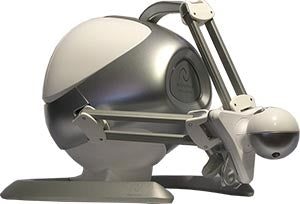What is Haptics?
Haptics is the science that refers to our sense of touch. There are scientific researchers who study the field of haptics, and there is even haptics research that does not utilize robotics or computers.
In fields of computing, haptics refers to adding a sense of touch primarily through robotic or mechanical devices. Haptic devices come in many shapes and sizes, and they can create an amazingly realistic sense of touch. Monitors allow people to see graphics, speakers allow people to hear audio, and haptic devices allow people to use their sense of touch. A haptic device can create the sensation of a gun recoil, the feel of the angular acceleration of swinging a ball on a piece of string, a scalpel or needle in a surgical simulator, or even let people feel across the surface of objects, feeling both textures and the forces of the surface itself. Even today, most people don't realize that the concept even exists. Similar to moving pictures in the 1920's, it is something that has to be tried to fully understand. One touch is worth a thousand pictures.
Haptic devices often are described by their Degrees of Freedom (DOF), or in other words, the number of different ways they can move or create forces. A simple haptic device like an XBox or Playstation controller has 1 DOF (of output - they have many DOFs of input). They have one motor, and that one motor can create rumble types of forces. Complex haptic devices that can move anywhere in space (x,y,z) and create forces in any direction are 3 DOF devices. A haptic device that can move anywhere in space and can also track rotations and create rotational forces (torques) around 3 more degrees of freedom (such as roll, pitch, and yaw) would be a 6 DOF device.

The Novint Falcon* is a 3 DOF haptic device. It can track positions and create forces when the handle moves right-left (x), forward backward (y), and up-down (z). It has been used both as a 3D touch video game controller as well as a high fidelity haptic research device. When the handle on the Falcon moves, a computer keeps track of where the handle moves and then calculates what forces should be generated. For example, you can move the handle and watch a 3D cursor move on the screen. When the 3D cursor touches a virtual object, motors in the device turn on (there are 3 motors, one for each degree of freedom) and you feel the force. There is complex math that describes how much each motor should turn on to create a force in any direction. The motors are updated 1000 times per second (or 1000 hz, known as the servo rate) which gives a smooth and realistic sense of touch. Then, software algorithms can be created to simulate forces that one wants to feel. An algorithm can create the forces when you touch an object, the texture of something smooth vs rubbery vs rough, or effects like the feel of a baseball slapping into a glove. Algorithms can become more and more complex to a point where a virtual surgery can be simulated, and a real life doctor can train on a virtual patient, learning a procedure well before ever touching a live patient.
The Falcon is an amazing device, in that it can simulate that level of touch (e.g. a virtual surgery), yet it is robust enough for video gamers and also inexpensive at a consumer level price point.
* - Novint and Novint Falcon are trademarks of Novint Technologies Inc. All product and company names are trademarks™ or registered® trademarks of their respective holders. Use of them does not imply any affiliation with or endorsement by them.
